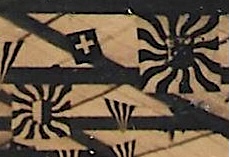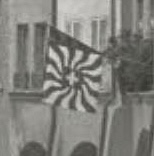![[Swiss flagge]](../images/c/ch_oly1948.jpg) image located by Martin Karner
image located by Martin Karner
Last modified: 2025-11-01 by martin karner
Keywords: switzerland |
Links: FOTW homepage |
search |
disclaimer and copyright |
write us |
mirrors
![[Swiss peace flag]](../images/c/ch_pea.gif) image by Evan Rolfe
image by Evan Rolfe![[Flag of Switzerland-Iceland Association]](../images/c/ch_chisa.gif)
The Switzerland-Iceland Association (Association Suisse-Islande) was founded
in 1988 in Geneva (Switzerland) by Léonard Pierre Closuit. Sent in 1978 to
Iceland by the Botanical Garden of Geneva, Closuit fell in love with Iceland and
founded an association "to promote cultural and artistic exchanges between the
two countries". On 25 October 2008, the association held its 19th General
Assembly in Martigny (Valais, Switzerland). Reporting the event on 27 October
2008, the newspaper "Le Nouvelliste" shows a photograph of the board members of
the association, with the association's flag hanging on the wall. The flag is a
combination of the symbols of the two countries. The perspective does not allow
to restore the specification of the flag, which appears to be made of an
Icelandic flag with the cross centered and a Swiss "cross" superimposed in the
middle. The Swiss "cross" is indeed disk-shaped, even if the disk seems to have
been "cut" along the outer edges of the cross arms.
http://www.lenouvelliste.ch/fr/news/valais/sur-un-meme-drapeau_9-114114
More on the banker-explorer Léonard-Pierre Closuit (b. 1931) in the
Encyclopaedia of Valais:
http://www.vs.ch/encyclo/navig.asp?mnu=know&idRubrique=1771&idLangue=1
Ivan Sache, 3 November 2008
![[Decorative Swiss flag]](../images/c/ch-fla.jpg)
![[Decor. Swiss cantons flags - postcard]](../images/c/ch_fla70.jpg)
![[Decorative Swiss cantons flags]](../images/c/ch-ge_pmb.jpg)
Aleksandar Nemet noted photographs of the Swiss flag with flames along one
edge (picture #1 [source],
picture [source]). This is a decorative Swiss
national flag, which is (as far as I know) only hoisted on a bridge in Geneva city.
On this bridge all the [cantonal] flags fly together with the Swiss flag for a mere
decorative purpose. All these flags on this specific bridge over the Rhodan
river, at the outflow from Geneva Lake, show a special pattern, which consists
of little flames along one or more borders of the flag (see also postcards from 1950s,
1960s and 1970s [#2] with cantonal flags). Flames, though also sometimes seen
in 17th and 18th century military flags all across Europe, are a specific Swiss flag design element since
the 17th century until today. Flames may be placed across the flag or in the four areas separated by a
white cross in varied ways, or at the edges of a flag or at the edges of a cross, or in any other possible
way (like for instance in our case here).
[The referenced pictures here show both the same kind of flag. The flags may be wrapped around the
pole like here and thus give the wrong impression to have the flames only on one side.]
Emil Dreyer, 21 November 2008
The bridge is the famous Mont-Blanc bridge ("pont du
Mont-Blanc"), built in 1902–1903 and enlarged in 1964–1965. Photo
showing the flag display here (picture #3).
During the last football European championship the
flags were replaced by the official UEFA Euro 2008 Genève flags.
Ivan Sache, 22 November 2008
See also: FLAMMULETS in Dictionary of Vexillology
![[Swiss flagge]](../images/c/ch_oly1948.jpg) image located by Martin Karner
image located by Martin Karner
A Swiss newspaper published an article about the use of airplanes at the Winter Olympic Games of 1928
and 1948 in St. Moritz (Grisons). One photo from 1948 shows a so-called
"Flagge" (vertical banner) with the Swiss cross on red, a vertical flag hoisted from a crossbar in
the manner of a gonfanon. The lower end of the flag is not visible. The special thing about the flag is
the cross, which is not centered or placed in the hoist as usual with these flags, but offset towards the
upper end. It has neither the design of "Flaggen" we present on FOTW with
the cross in the hoist and a bicolour fly part. The airplane with the HB-ARU marking is a "Fieseler
Storch" Fi-156. These planes could fly very slow and were well suited for photography.
(Source: Südostschweiz am Wochenende/Bündner Zeitung, suedostschweiz.ch, 25 February 2023)
Martin Karner, 3 March 2023
![[ATVAS]](../images/c/ch-ti}atvas.jpg) image located by Martin Karner
image located by Martin Karner
The Associazione Ticinese volontari antifascisti di Spagna was an association of former volunteer fighters in the Spanish Civil War
and friends. It existed from 1976 to 1991. Around 80 citizens of Ticino had joined the Republican forces (over 800 from whole Switzerland). After its dissolution
the association's documents were transferred to the Fondazione Pellegrini Canevascini, which is dedicated to the social history of
Italian speaking Switzerland. The flags came into the care of the Cantonal Library in Mendrisio.
The association's flag is presented on the website of the mentioned foundation.
It adopts the colours of the Spanish Republic: purple, yellow and red in a vertical tricolor. The black inscription on the upper half
reads: "ass. Ticinese volontari | antifascisti di Spagna | 1936 – 1939". The the first two lines are arranged in an upward arc. The flag has golden fringes
on three sides. Measurements: 145x100 cm.
Martin Karner, 18 July 2023
![[watchmaker flag]](../images/c/ch-ne$fordrf.jpg) image located by Martin Karner
image located by Martin Karner
This flag from 1898 is of the "Federation of sharpeners, dismantlers, refitters and bolt makers in the watch industry" (Fédération des ouvriers
repasseurs, démonteurs, remonteurs et faiseurs d'échappements de l'industrie horlogère), Neuchâtel canton. This federation was still a professional
fraternity, not a trade union. It was not until 1915 that the watchmakers organized themselves into a trade union at national level, the
Swiss Metalworkers' and Watchmakers' Union.
The square flag shows on a light blue or grey field a golden pocket watch, surrounded by a ring on which the zodiac is depicted in similar colours as the clock.
The clockwork is visible. A few laurel branches peek out from behind the ring. In front of the ring at the bottom a winged sand glass is depicted. Above and below the
watch the motto is arranged in two bows: "L'INTELLIGENCE ET L'ADRESSE / FONT L'EXCELLENT OUVRIER" (Intelligence and skill make the excellent worker).
The flag has golden fringes on three sides. Location: Musée d'histoire, La Chaux-de-Fonds (source).
Martin Karner, 24 July 2023



 images located by Martin Karner
images located by Martin KarnerAt the beginning of the 20th century, flamed flags were still in use, with the white cross replaced by
a (baroque) shield in the centre of the flag. These decorative flags had been used until WWII and then
somewhat forgotten in preference of the current cantonal flags. Not only cantonal flags were made with
this design, but also the Swiss national flag.
Photo #1 above shows cantonal flags with the flame pattern (detail of postcard of the Federal Shooting 1929 in
Bellinzona TI).
Photo #2 shows a flamed Swiss national flag, used by playing school children in
Wabern BE, ca. 1914 (picture, source).
Photo #3 was made in Bern on 1.8.1936 (national holiday | picture, source).
Today this kind of flags are being produced again (photo #4: club members at 300m shooting range Pelindaba,
South Africa, 2018 | picture, source).
Pascal Gross, 30 June 2002 / Martin Karner, 6 December 2023
See also:
![[Flag of Artillery Club BL]](../images/c/ch_av-bl.jpg) image located by Martin Karner
image located by Martin Karner
On an auction platform this b/w photo from the 1940s is
offered, showing a group of military personnel and the square flag of the Artillery Club Baselland
(Artillerie-Verein Baselland). The colours of the upper part must be red and white, corresponding
to the cantonal colours. The lower part probably has golden lettering on red. (source)
The purpose of the Artillery Clubs is to increase skill in using the weapons outside of regular military
service. The first of those clubs in Switzerland have been founded in the first half of the 19th century.
There are cantonal as well as local clubs. The Baselland club was founded in
1888, in the same year the national Association of Swiss Artillery Clubs (Centralverband Schweizerischer
Artillerievereine) was founded (later Verband Schweizerischer Artillerievereine). In 1890 the
first Artillery Day (Artillerietag) was organized, with shooting competitions and presentation of
the weapons for the public.
(source)
![[Flag of ASSA]](../images/c/ch_assa.jpg) image located by Martin Karner
image located by Martin Karner
The flag of the national Asscociation (introduced 1937), French version (Association suisse des
Sociétés d'Artillerie). (source)
Website National Association (VSAV/ASSA): https://vsav.info
Martin Karner, 6 December 2023
![[All cantons flag]](../images/c/ch_5x5.gif) image by António Martins, 22 August 2024
image by António Martins, 22 August 2024
This is a makeshift flag and not an official flag at all, but it sure does portray a
colorful design, and it seems that it is used quite often (Photo by Esteban Rivera, 2011).
The flag is a red background square featuring 25 (26) Cantons in five rows of five, from top to bottom, from
left to right, as follows [in the official order]:
1st row: Zürich, Bern, Luzern, Uri, Schwyz
2nd row: Obwalden, Nidwalden, Glarus, Zug, Fribourg
3rd row: Solothurn, Basel-Stadt, Basel-Landschaft, Schaffhausen, Appenzell (AI+AR)*
4th row: St. Gallen, Graubünden, Aargau, Thurgau, Ticino
5th row: Vaud, Valais, Neuchâtel, Genève, Jura
* The half-cantons AI and AR have to share a field with their common flag
Esteban Rivera, 7 January 2024
See also: PATCHWORK FLAG in Dictionary of Vexillology
 image located by Martin Karner
image located by Martin KarnerFlag of the Society of Heavy Artillery Drivers, Battery 1, Geneva, Switzerland.
The three shields in the center show the Coat of Arms of Switzerland, Geneva and the emblem of the Artillery
drivers.
French inscription on the red circle: "Société Batterie Canons Lourds Auto 1 | Patrie –
Famille – Amitié | 1934" (in capital letters).
107x110 cm, with red-yellow tassel. Obverse and reverse are identical.
Martin Karner, 23 June 2025